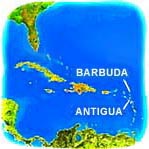|


Book
Your Vacation
with TNT!
|
Talk to fellow travellers...
Come visit our newsgroup for the latest info.
 All
the signs pointed towards Antigua. The island had warm, steady winds, a complex coastline of
safe harbors, and a protective, nearly unbroken wall of coral
reef. It would make a perfect place to hide a fleet. And so in
1784 the legendary Admiral Horatio Nelson
sailed to Antigua and established Great Britain's most important
Caribbean base. Little did he know that over 200 years later the
same unique characteristics that attracted the Royal Navy would
transform Antigua and Barbuda in one of the Caribbean's premier
tourist destinations. All
the signs pointed towards Antigua. The island had warm, steady winds, a complex coastline of
safe harbors, and a protective, nearly unbroken wall of coral
reef. It would make a perfect place to hide a fleet. And so in
1784 the legendary Admiral Horatio Nelson
sailed to Antigua and established Great Britain's most important
Caribbean base. Little did he know that over 200 years later the
same unique characteristics that attracted the Royal Navy would
transform Antigua and Barbuda in one of the Caribbean's premier
tourist destinations.
The signs are still there, they
just point to different things. The Trade Winds that once blew
British men-of-war safely into English
Harbour now fuel one of the world's foremost maritime events, Sailing
Week. The expansive, winding coastline that made Antigua
difficult for outsiders to navigate is where today's trekkers
encounter a tremendous wealth of secluded, powdery soft beaches.
The coral reefs, once the bane of marauding enemy ships, now
attract snorkelers and scuba divers
from all over the world. And the fascinating little island of Barbuda
-- once a scavenger's paradise because so many ships wrecked on
its reefs -- is now home to one of the region's most significant
bird sanctuaries.
Location:
 Antigua (pronounced An-tee'ga) and Barbuda are located in the
middle of the Leeward Islands in the Eastern Caribbean, roughly
17 degrees north of the equator. To the south are the islands of
Montserrat and Guadaloupe, and to the north and west are Nevis,
St. Kitts, St. Barts, and St. Martin.
Antigua (pronounced An-tee'ga) and Barbuda are located in the
middle of the Leeward Islands in the Eastern Caribbean, roughly
17 degrees north of the equator. To the south are the islands of
Montserrat and Guadaloupe, and to the north and west are Nevis,
St. Kitts, St. Barts, and St. Martin.
Size:
Antigua, the largest of the English-speaking
Leeward Islands, is about 14 miles long and 11 miles wide,
encompassing 108 square miles. Its highest point is Boggy Peak
(1319 ft.), located in the southwestern corner of the island.
Barbuda, a flat coral island with an area of only 68 square
miles, lies approximately 30 miles due north. The nation also
includes the tiny (0.6 square mile) uninhabited island of
Redonda, now a nature preserve. The current population for the
nation is approximately 68,000 and its capital is St.
John's on Antigua.
Climate:
Temperatures generally range from the
mid-seventies in the winter to the mid-eighties in the summer.
Annual rainfall averages only 45 inches, making it the sunniest
of the Eastern Caribbean Islands, and the northeast trade winds
are nearly constant, flagging only in September. Low humidity
year-round.



We love feedback; please
contact info@interknowledge.com
with any comments, suggestions or questions.
This page, and all contents
of this Web site are Copyright (c) 1996-2003 by interKnowledge
Corp., New York, NY. All rights reserved.
|